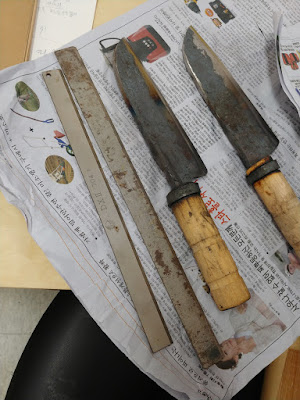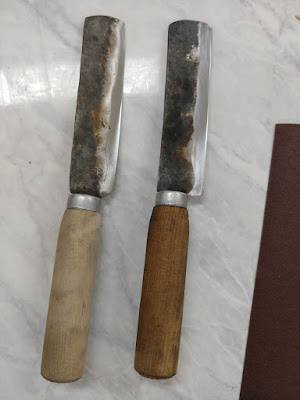The site I visited houses the studios of the best and brightest up-and-coming ICP (intangible cultural property) bearers. They have trained for at least five years under national ICPH (H is for "holder" and the shorthand is to say they are national treasures but that term is usually used for objects/places). Of those trainees, the most promising are chosen for a yearlong residency (I may have this length of period wrong) where they are given studio space, housing, and a stipend to continue their work. The intros I got were very sweeping, no names or business cards, so forgive that lack. This is the studio of a potter.
She married into a well-known family of onggi makers, where American Adam Field studied years ago. I had a feeling when she started to talk about this that she would know him. He and I connected over a decade ago talking about our respective experiences learning traditional crafts in Korea.
Because I've been so steeped in toolmakers for the last five years, this kind of thing makes me go insane. This is the studio of the wood furniture maker (somokjang).
He has tons of tools, naturally, and was so helpful later on when helping guide me with knife sharpening.
So much wood! I haven't asked him yet where he was coming from because it must have been a lot of work to bring everything here. Most of the people here are not from Jeonju so they will spend the week in the studio here and then weekends back home or doing other kinds of research/work in other areas.Since I've spent so many years trying to replicate Korean knives (while knowing almost nothing about knives in general), this also made me kind of crazy. This is the studio of Kim Dae-seong, the son of the national ICPH of fan making. He's actually from Jeonju, born and bred, and has been extremely helpful.
When we first met, I asked him about drawing maps onto fans and he said well you can draw/paint whatever you want on blank ones. But I meant one particular fan I had seen in the maps division of the Library of Congress back in D.C., and happened to have my computer on me so I could show him. He had never seen something like that before, plus the map happened to be of Jeolla province, so he immediately asked if I could share the pics.
I sent them to him plus a link to the object listing online, whose picture does it no justice. It's always so gratifying to meet likeminded people who get excited about the same obscure things that you do. I loved this detail of his hand-painted decoration. Usually I think the decorations are burned into the bamboo.
This person is I believe descended from the national treasure of metal clasp making or generally the metal pieces needed to finish furniture and metal craft more generally (duseokjang). His hometown is Tongyeong and I immediately recognized the picture of his father because I had seen it so often in Tongyeong when I was studying.
His grandfather also came from this tradition. I have no idea how this works, if the wood worker brings you the piece and you finish it with the metal joinery or what. There are too many things in the world to learn and no matter how hard I try, I will remain ignorant of most of what is out there.This is some of the work of Kim So-yeon, who works in nubi or traditional hand quilting. There was a mix of traditional and then what looked like experimental pieces, and a mix of hand and machine work.
I would love to have a piece like this to nestle into.
None of my pictures do the work justice, so you have to take my word for the tiny tiny delicate stitches.
This little piece in her window reminded me of one of my artists' books student's work, always fun to make connections between the work of young people around the world.
The whole reason I went back a few weeks later was because I asked my bamboo screen teacher for a favor and he suggested finding a fan maker in Jeonju to get a smith to make me bamboo knives. I remembered Mr. Kim who made fans and asked him for help, and he offered immediately to take me to a local smith who has just been named a Jeolla-do ICPH. I went a bit overboard and ordered four knives, two big and two small, out of my general panic of never having enough Korean knives. That was kind of a big mistake because he charged a LOT of money, raising his prices after getting this designation but otherwise having no good reason to do so. His work is middling but he was the closest person to do the job. I have regrets and my bank account has been taking a real beating lately, but what's done is done.
Back in the studio, Mr. Kim quickly clarified a LOT of questions I had that no one else had been able to answer. One was about the small bamboo knife that the hanji bal maker had and couldn't explain to me where to find another. Turns out that all bamboo workers just grind and sharpen FILES to use as knives. Aha!! I knew that pattern was familiar, as well as the slope rising to the middle of the tool, duh. Not only that, but he showed me where and what type to buy online. I am finally coming to this realization that the keys that I'm now looking for are not solely held by old grumpy men (or creepy ones), but by makers of MY generation: those who have made a commitment to the work for years, have made sacrifices to continue the work, have studied with the older ICPH, and yet know how to operate in the current climate. Meaning basic stuff like, being able to source their tools online!!
The wood furniture maker across the hallway came over to help after we got the four knives and had to sharpen the smaller ones. These are the larger ones, based on an old knife we brought to the smith, alongside high speed steel from Japan. Which is extremely easy to order online and common to work with. The only reason I paid for these Korean ones was to try and bring back a 'taste of Korea' instead of only showing Japanese knives to Americans (which would only confuse them further, as they so often conflate Korea with Japan).
So what I have are two sets of these. I sent pictures to my teacher in Tongyeong, who was so upset because he said I got ripped off. He said the large knife is probably too unwieldy for me to use and the small knife is 1. too long and 2. not wide enough in the back. I've already cut myself on the small one, which Mr. Kim took pains to show me how to sharpen.
I mean, this took days. I spent one night there trying to work against a 1000 grit water stone and made a mess as this is really not my forte. I was so tired the next day from dental work and travel recovery that I didn't go back, which is I think when he just sharpened the other one for me entirely.
The first night we worked with the stone upright but I asked why, as I usually work on the wider flat face of the stone (sending a note to the house gods back home: where is my water stone? It disappeared in my move. Please have it reappear when I return).
This was the final step, drawing the blade on both sides against canvas the same number of times. I know Mr. Kim felt kind of badly about the smith doing such a crappy job for too much money, so maybe this is why he spent so much time making sure they were sharpened well. But they are so much sharper than the very dull knives my teacher in Tongyeong had me use. There's pros and cons to that, which all involve slicing your hands open. Either way, it can happen, though I do know that a dull knife opens you up to more injury.
The wood furniture maker did a whole explanation of sharpening and burrs, which has been explained to me before, but I feel like certain things will never penetrate my brain. I have a weird mental/physical block when it comes to knife work that maybe is like how I am about reading Korean. I know I can do it, but I don't want to. Which is not helpful because I need to work with knives and enjoy those results, just as I need to read Korean and write and speak and get a lot out of that. I think it's old immature behavior: I don't like the parts that I'm not good at, where I have to work harder than the things that come to me naturally.
Mr. Kim finally moved onto the 2000 grit stone and I was so grateful that he was going to take it all the way to the end without having me attempt again as it would just set us behind and we are both very busy folks.
This was the final stone at 3000, which was really only for a quick polish and not necessary for this type of knife. Now that I have these subpar, heavy knives, I am going to eventually make another trip to Tongyeong to visit my teacher and see how well/poorly they work on actual bamboo. Otherwise, he said at least I can put them in shows that display Korean tools. That's not very satisfying to me, but I made the mistake of not turning around when the blacksmith quoted such a high prices (I misunderstood at first, and Mr. Kim tried to lower the price but was refused), and for going in such a rush that I didn't take any measurements that I took along with me to demand at least the blade length and thickness. I'm doing a ton of learning from mistakes here. But am so glad to finally be connecting with people my age and younger in the field. It's like I'm waking from a coma in the nick of time.


























No comments:
Post a Comment